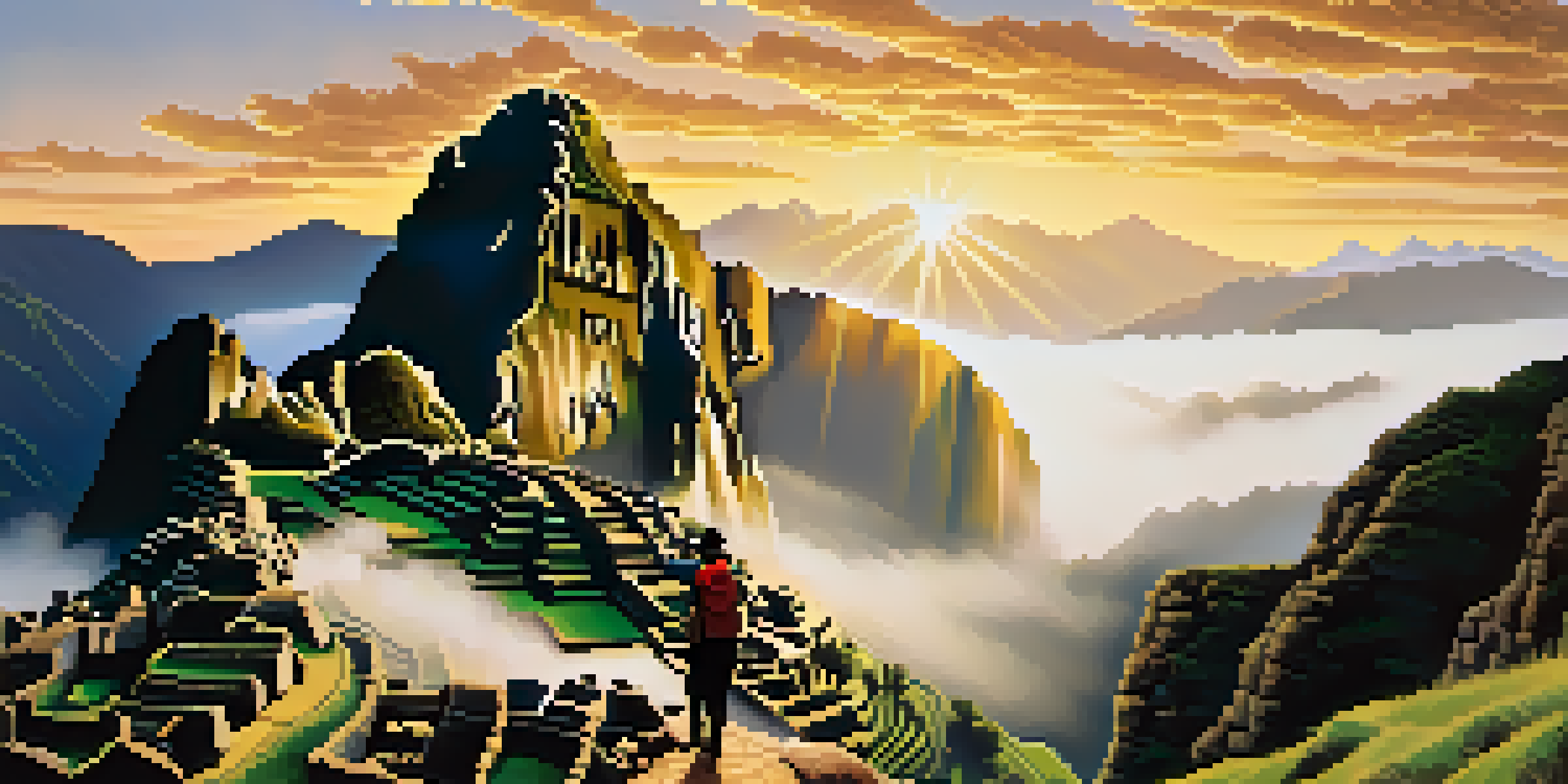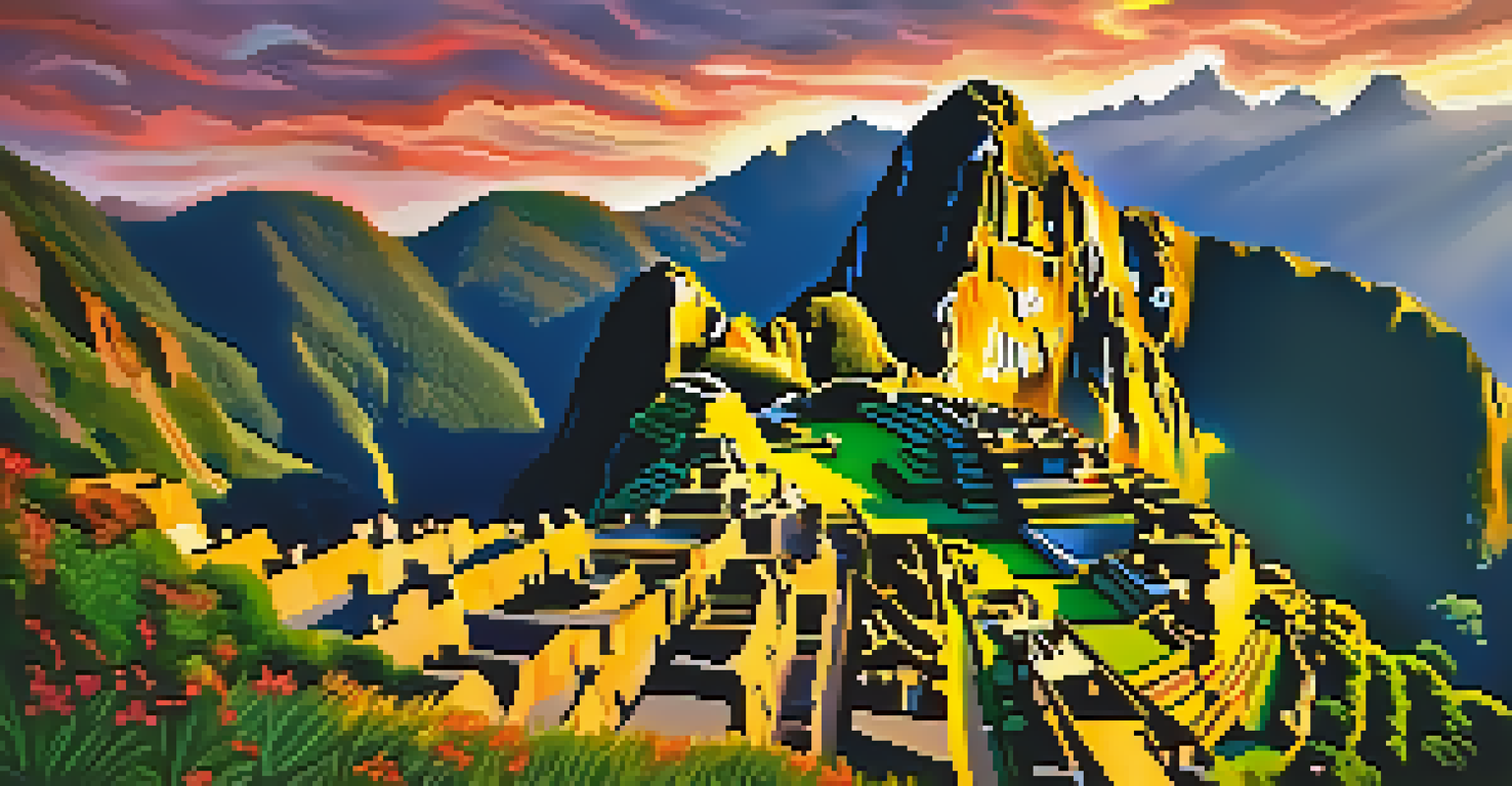Inca Trail: 4-Day Trekking Itinerary to Machu Picchu

Overview of the Inca Trail Trekking Experience
The Inca Trail is a legendary trek that leads adventurers to Machu Picchu, the iconic lost city of the Incas. This four-day journey takes you through stunning landscapes, ancient ruins, and diverse ecosystems that showcase the beauty of the Andes. As you walk along the original stone paths built by the Incas, you'll be immersed in history and culture, making the experience truly unforgettable.
The journey of a thousand miles begins with one step.
Each day of the trek offers a unique blend of natural wonders and archaeological sites. From lush cloud forests to high mountain passes, the trail is a feast for the senses. Along the way, you'll encounter fellow trekkers and local porters who share their stories, adding to the rich tapestry of this adventure.
Whether you’re an experienced hiker or a beginner, the Inca Trail provides a rewarding challenge, with breathtaking views and a connection to a remarkable past. It’s not just a hike; it’s a journey into the heart of a civilization that once thrived in these mountains.
Day 1: Starting the Adventure at Kilometer 82
Your Inca Trail journey begins at Kilometer 82, the official starting point. After a brief check-in, you'll hit the trail, filled with excitement and anticipation. The first day is relatively easy, taking you through picturesque valleys and small villages where you can catch glimpses of local life.

As you walk, you'll notice the stunning views of the Urubamba River and the surrounding mountains. The trail is dotted with archaeological sites, including the impressive ruins of Llaqtapata, which offer a taste of what’s to come. The day ends at your first campsite, where you can relax and enjoy a hearty meal prepared by your trekking team.
Experience the Inca Trail's Beauty
The Inca Trail offers a stunning journey through diverse ecosystems, ancient ruins, and breathtaking landscapes that connect trekkers to the Inca civilization.
As night falls, the stars come out in a breathtaking display, reminding you of the vastness of the universe. This first night under the Andean sky sets the stage for the adventures ahead, with the promise of even more spectacular sights and experiences.
Day 2: The Challenging Ascent to Dead Woman’s Pass
Day two is often considered the most challenging yet rewarding part of the trek. You’ll rise early to tackle the ascent to Dead Woman’s Pass, the highest point on the Inca Trail at 4,215 meters (13,828 feet). The climb involves a series of steep steps that can be grueling, but the sense of accomplishment is worth every step.
In every walk with nature one receives far more than he seeks.
As you ascend, take breaks to catch your breath and soak in the panoramic views of the surrounding peaks and valleys. You'll also encounter the enchanting cloud forest, where the vegetation transforms into a lush paradise filled with unique flora and fauna. This diversity highlights the ecological richness of the region.
Reaching Dead Woman’s Pass is a moment of triumph, and the descent that follows offers a different kind of beauty. The trail leads you through ancient Inca ruins and stunning landscapes, reminding you of the incredible history and culture that surrounds you as you continue toward your destination.
Day 3: Exploring Ruins and Scenic Views
On Day three, you'll have the chance to explore several significant Inca ruins, including Runkuracay and Sayacmarca. Each site offers a glimpse into the architectural genius of the Incas, surrounded by breathtaking views. The history embedded in these ruins helps you appreciate the significance of this ancient civilization.
The trail continues to weave through beautiful landscapes, including vibrant valleys and high-altitude ecosystems. Keep your camera ready, as the scenery changes dramatically, providing countless photo opportunities. The combination of natural beauty and historical richness makes this day particularly special.
Prepare for a Challenging Trek
Physical preparation, including cardiovascular and strength training, is essential for enjoying the demanding ascent and overall hiking experience.
As you approach your campsite for the night, the anticipation of reaching Machu Picchu builds. Sharing stories with fellow trekkers around the campfire adds to the camaraderie that develops on this journey, creating lasting memories that will stay with you long after the trek.
Day 4: The Final Push to Machu Picchu
The final day of your trek begins before dawn, as you make your way to the Sun Gate (Inti Punku). This is the moment you've been waiting for, as you catch your first glimpse of Machu Picchu bathed in the soft morning light. The experience is nothing short of magical, and it’s a perfect reward for your hard work over the past three days.
After soaking in the view, you'll descend into the ancient citadel itself, where a guided tour will unveil the mysteries of Machu Picchu. Learn about its history, architecture, and the significance of various structures like the Temple of the Sun and the Intihuatana stone. Each stone tells a story, connecting you to the past in a profound way.
Once the tour concludes, you’ll have some free time to explore on your own. Whether you want to hike to Huayna Picchu for even more stunning views or simply wander through the ruins, the day is yours to enjoy. As you reflect on your incredible journey along the Inca Trail, you’ll realize this trek is about more than just reaching a destination; it’s about the adventure and the connections you’ve made along the way.
Essential Packing Tips for the Inca Trail
Packing for the Inca Trail can feel daunting, but with the right essentials, you'll be well-prepared for your adventure. Start with a good-quality backpack that fits comfortably and distributes weight evenly. Remember to pack light, focusing on items you'll truly need like clothing layers, a rain jacket, and sturdy hiking boots.
Don’t forget to bring a reusable water bottle to stay hydrated and a small first-aid kit for any minor injuries. Snacks like energy bars or trail mix can provide quick energy boosts during long hiking stretches. Additionally, consider packing a lightweight sleeping bag, as nights can get chilly in the mountains.
Respect Local Culture on the Trail
Being mindful of cultural customs and practicing 'Leave No Trace' principles is crucial to preserving the Inca Trail's heritage and environment.
Lastly, ensure you have your trekking permits and identification handy, as they’ll be checked at various points along the trail. Being organized and well-prepared will not only make your trek more enjoyable but also help you focus on the amazing experiences ahead.
Health and Fitness Preparation for the Trek
Preparing your body for the Inca Trail is key to fully enjoying the experience. Start by incorporating regular cardiovascular exercises like hiking, running, or cycling into your routine. Aim for at least 30 minutes of moderate exercise several times a week to build stamina and endurance.
Strength training is also beneficial, particularly for your legs and core, as these muscle groups will be put to the test on the trek. Squats, lunges, and planks can help to strengthen your muscles and improve your overall hiking performance. Flexibility exercises, such as yoga or stretching, can aid in preventing injuries and enhancing your mobility.

Finally, consider acclimatizing to high altitudes by spending time in similar environments before your trek. This can help your body adjust to lower oxygen levels, making the ascent to Dead Woman’s Pass more manageable. Proper preparation will empower you to embrace the challenges of the trek with confidence.
Cultural Etiquette and Respect on the Trail
As you embark on the Inca Trail, it's important to be mindful of the cultural significance of the areas you will visit. The Inca civilization has a rich heritage, and respecting local customs and traditions is essential. Always ask for permission before taking photos of people or sacred sites, as this shows respect for their culture.
Be mindful of your waste and follow the principles of 'Leave No Trace' to preserve the natural beauty of the trail. Carry out all your trash and avoid picking plants or disturbing wildlife. This not only keeps the environment pristine but also honors the land that has significant cultural importance.
Lastly, take time to engage with local porters and guides. They are an integral part of the trekking experience, and showing appreciation for their hard work fosters a sense of community. By respecting the culture and environment, you contribute positively to the legacy of the Inca Trail and ensure its preservation for future generations.